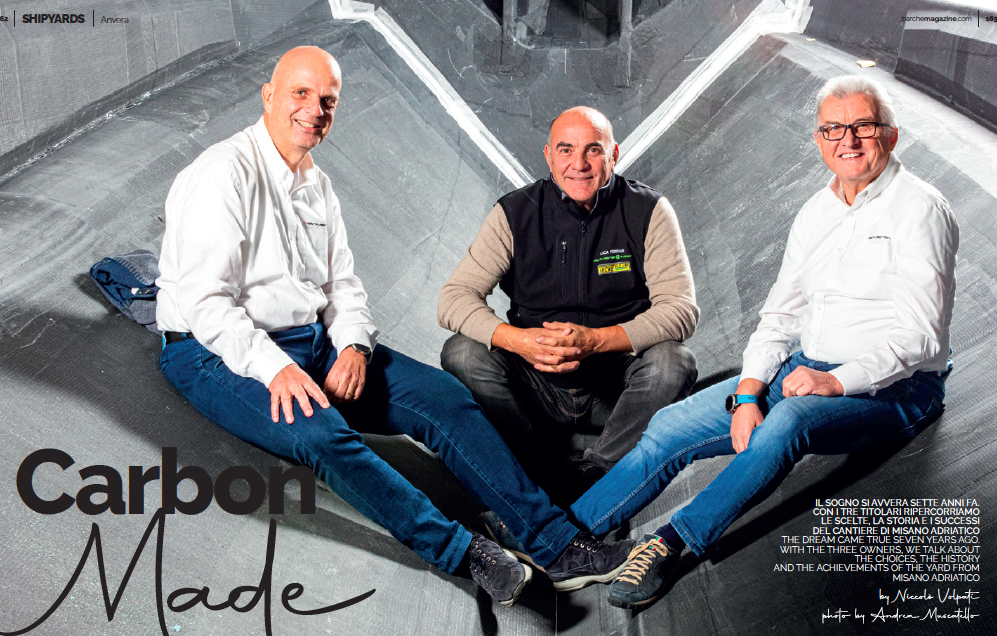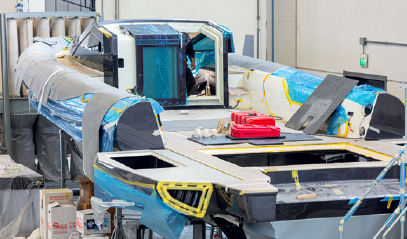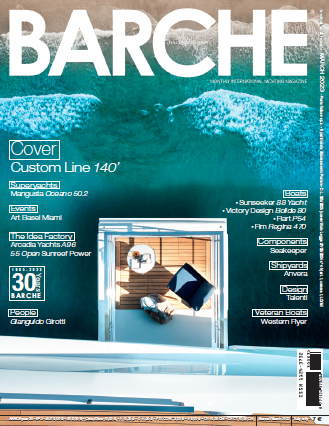BARCHE MAGAZINE EDITORIAL – MARCH 2023
LG-Yacht is the name of the shipyard, and Anvera is the brand. It has three founding partners, Giancarlo Galeone, Luca Ferrari and Gilberto Grassi. After working together in the Ferretti Group for 25 years, they have embarked on this new adventure together. Gilberto Grassi was the production manager and head of the style centre at Gruppo Ferretti for many years. Luca Ferrari has always been part of the Ferretti family, not in a figurative sense, but literally, since his mother was one of the founders of Ferretti. He has always dealt with research and development and has launched several hundred prototypes throughout his career. Giancarlo Galeone is in charge of General Management at Anvera and was also a long-time employee at Gruppo Ferretti.
Let’s start from the end. Or rather, from what comes to my mind after listening to Giancarlo Galeone, Luca Ferrari and Gilberto Grassi for a few hours as they tell me about Anvera shipyard’s seven years of history. As they speak, I realise that they never once use the word rib to define their products, on a few occasions they spoke of dinghies, but, above all, in 95% of all cases they used the term boats. This definition says a lot about Anvera’s philosophy.
Now let’s rewind the tape and go back to the beginning. «The first time we sat around table to draft this project was in late 2014», Giancarlo Galeone tells me. «We were sure about one thing: we wanted to do what we liked. Something we truly felt as our own». Those were the days when daycruisers started appearing on the market. More and more yards started to develop this type of vessel and the three founding partners decided to ride that wave. But they needed to do something different. Something that didn’t exist yet. Carbon was not unknown, but many of those who said they used it didn’t always do it the right way. «Composite was a technology that started to assert itself from the ’90s on», says Luca Ferrari.
«First in the world of sailing races and immediately afterwards in offshore.
I remember the 48 HP designed by Buzzi, a beautiful boat, maybe even too much ahead of its time. If it still existed today it would still be quite a star, both in terms of design and in terms of performance». Anvera’s main characteristic is using carbon with epoxy resin and doing everything in-house, without contractors. The result highlights lightness and resistance, low consumption and long-lasting quality. It is no coincidence that Anvera’s models consume from 3 to 5 litres per mile at cruise speed depending on the size and power of their engines. The particular feature that distinguishes them from other models is that everything – truly everything – is made of carbon. Not just the superstructure or some parts to lighten the overall displacement, nor simply a few reinforcements of the hull. Almost obsessive full of carbon, since even the engine brackets are made of carbon. They created a steel mould and then made it in composite with the benefit of reducing the weight by one-fourth while maintaining the same resistance as steel. To make boats this way you need an adequate facility.
The first thing they do in Misano Adriatico is to paint the mould. Even the paint job is done in-house so they can meet the at times highly extravagant needs they get from shipowners. The moulds for the hulls are split in two because this way it is easier to place the carbon fibres. If the mould were made in one single piece, you would probably have to work upside down towards the bow to spread the composite. The V is narrow to perfectly cut through the waves but also for those who need to work on it during construction. With the mould split in half lengthwise this problem ceases to exist. First, you do half the hull, then the other half, and then you move on to unite these two parts. There is vacuum sealing, and to be able to do everything in-house in the yard you need to pre-cook all the elements that are mounted on board: bulkheads, floor timbers, dunnage, hard top, and even cabinets. And, lastly, you reach the final cooking that uniforms all the carbon that was spread with the epoxy resin. The final cooking with the entire boat already assembled is done at 75° and lasts 14 hours, after which another 14 hours are needed for cooling. The times are very long, but they are necessary to achieve a top-quality product. The other feature I was impressed by is that it is not the mould that is moved around inside the yard, but rather the furnace. Usually, we see production lines with the hull moving through the yard with everything it needs inside gradually added and the deck closed. The cycle here is the same, but at Anvera it is the furnace moving, not the hull. The furnaces are placed on wheels that allow them to move inside the hangar. Their modular composition, on the other hand, allows them to adapt to the various sizes of the boats since the range goes from 42 to 58 feet. For instance, the resting time in the mould is much longer than it would be in a fibreglass boat because you need about four weeks to spread all the carbon. Consequently, although Anvera has three hangars for a total surface of 6.000 m2, it only produces a dozen boats a year.
A traditional shipyard will make the hull, pull it out of the mould and place it on four easels to start mounting the structures. This takes less time and takes up less space. «A normal shipyard, with people much less obsessed than us, could produce as many as 50 boats a year with 6.000 m2», as Gilberto Grassi states. «But this is not what we want to do. Our philosophy is to produce few pieces, but do it well. Our construction is more similar to the world of extremely high-level sailboat production than that of engine-powered boats». And maybe it is no coincidence that the shipyard’s collaborators include a structural engineer like Luca Olivari who already used composite in the ’90s and designed the Moro di Venezia and many other hulls from America’s Cup. All this attention to detail and construction quality is not a whim. We need it to meet the demands of our shipowners. The maxi ribs, and Anvera’s owners must forgive me for this definition, are often tenders of either a mega yacht or a mega villa. But they are also pleasant vessels to sail. And precisely shipowners fall in love with these boats more than others because they can sail them by themselves. This is why they require a very high standard of customization. Some want a damped seat, others a specific distance from the navigation bridge, some request made-to-measure ergonomics, and others again point out exactly where they want to place the throttle levers on the bridge. And the yard can answer all these needs.
This is probably why whoever owns one, keeps it forever. There aren’t a lot of second-hand Anveras out there. And the ones that are launched sail a lot, much more than the average motorboat or dinghy. The first example of the 58 covered 1,500 miles last summer. A 48 delivered in the spring came back to winterise in the yard in the fall after sailing a total of 600 hours. In other words, in one single season, it covered what a boat would normally achieve in six years. And when the owner no longer wants to get off his boat that means he is truly satisfied with his purchase.




